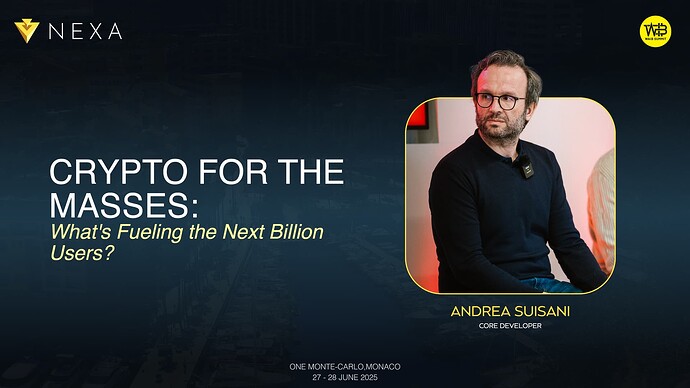The WAIB Summit in June 2025 lit up Monte Carlo, Monaco with two days of high-caliber discussions, networking, and visionary insights. As one of the world’s premier events focused on the convergence of Web3, AI, and blockchain, it drew in top voices from across the crypto ecosystem.
One of the standout moments came during the panel “What’s Fueling the Next Billion Users?”, where Andrea Suisani, Core Developer at Nexa (known in the community as Sickpig), joined an impressive lineup of speakers to unpack what it really takes to bring the next wave of users into crypto. Moderated by Zoltan from Cointelegraph, the panel featured thought leaders from OSL Pay, Crypto.com, OKX, Doors3, and Nexa, each offering a unique perspective on the challenges and opportunities ahead.
The whole panel discussion can be viewed here:
Grounding Crypto in its Original Purpose
Andrea opened his remarks by returning to the roots of crypto. For him and the Nexa team, mass adoption is about restoring the original vision of electronic peer-to-peer cash. “In places where banks don’t want customers”, Andrea noted, “crypto offers an open alternative. It gives people a way to transact freely and protect themselves from inflation or economic instability”.
His point hit home, especially when looking at real-world examples like Argentina, where citizens are already turning to crypto as a way to escape rampant inflation and financial exclusion.
Stablecoins, Simplicity & Everyday Use
Other panelists highlighted how stablecoins are quietly powering a major shift, especially in Asia, where over 60% of global crypto volume originates. Zain from OSL Pay compared the growing use of USDT to Visa and Mastercard, pointing out that more merchants are now embracing stablecoins for faster settlement and lower fees.
But as Karen from Doors3 emphasized, it’s not just about payments, it’s about frictionless experiences. “Mass adoption will happen”, she said, “when paying with crypto feels like using a debit card. No extra steps. No learning curve. Just tap and go”.
Thomas from Crypto.com echoed this, noting that many users already spend crypto via exchange-issued cards, even if they don’t think of it as ‘crypto payments’. The tech is already in people’s hands, now it’s about smoothing the user journey.
Usability, Scalability, and the Question of Trust
As the conversation turned toward challenges, Andrea brought up a critical point: scale. “If we want to serve 8 billion people”, he said, “we need infrastructure that doesn’t rely on permission from banks or centralized gatekeepers. We need to scale on-chain, securely and affordably”. It was a reminder that building usable technology is about making systems that can truly handle global demand.
Roy from OKX addressed the trust issue, pointing out that many users still hesitate to fully commit due to bad actors and opaque systems. Proof-of-reserve transparency, licensing, and self-custody tools are essential steps in rebuilding that trust. Karen added that while decentralization is the ideal, people still need to feel safe using crypto and that safety comes not only from code, but from clear communication and honest governance.
Crypto is Global — But Local Realities Matter
One of the strongest themes of the discussion was geography. As Karen put it, in countries like France, crypto is often seen as a luxury, an investment tool, not a necessity. But in regions like Latin America or West Africa, the story is different. Zain explained that in parts of Africa, local currencies are barely supported by the banking infrastructure. In these areas, stablecoins aren’t just a convenience, they’re a lifeline, and year-over-year growth of USDT and similar tokens in the region is exploding because people simply need better tools.
Andrea reaffirmed this perspective, tying it back to Nexa’s mission: to provide open financial infrastructure where none exists, without permission, and without compromise.
When Will We Reach One Billion Users?
Zoltan closed the session with a big question: How soon will we see the first billion crypto users?
Predictions varied. Thomas and Roy suggested that with institutional momentum and improved UX, we may only be one market cycle away. Karen emphasized the importance of retail, brand adoption, and regulatory clarity. Andrea, didn’t offer a date, but left the audience with a powerful message:
“If we stay true to our values — trustlessness, autonomy, and banking the unbanked — we’ll get there. Maybe not tomorrow. But sooner than people think.”
To Sum Up
The “Next Billion Users” panel was about people, principles, and the path forward. From stablecoins and real-world use cases to global inequality and infrastructure design, the future of crypto is being shaped now by the builders who refuse to compromise.

